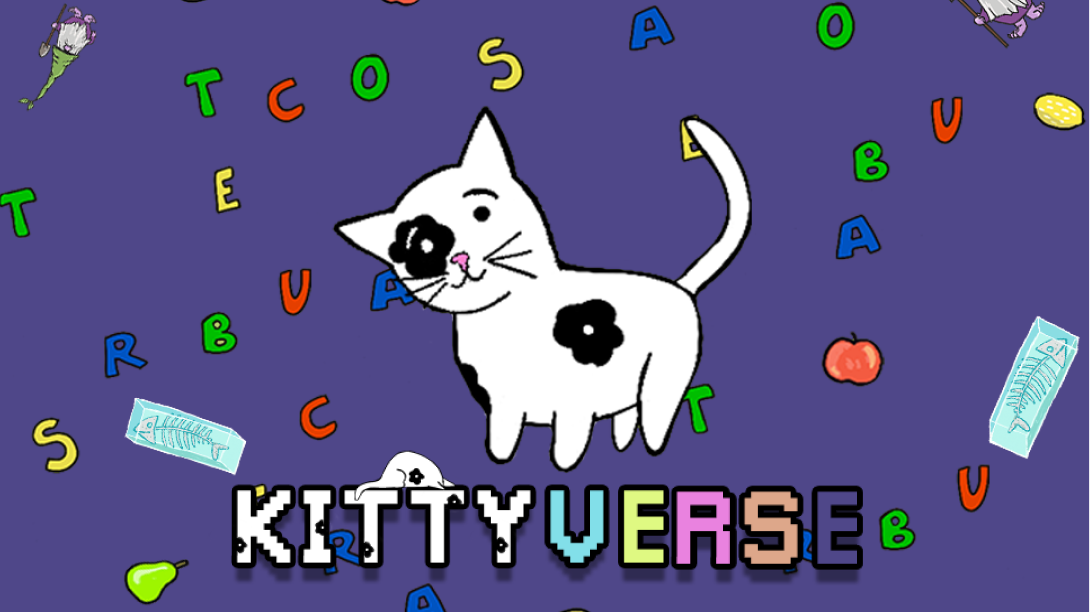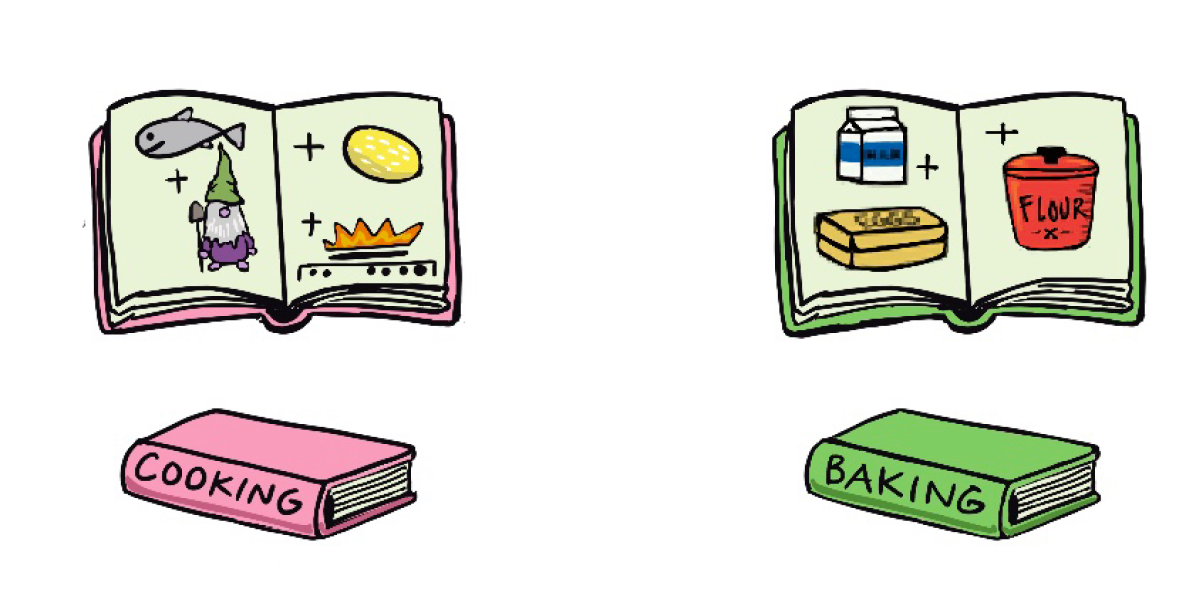Kittyverse
Kittyverse is a short (but fun!) point and click adventure game that prompts the player to solve puzzles in a foreign, colorful universe in order to get their cat back and go back home.
It was a submission for the Adventure Game Jam (2022).
Project Overview
Challenge
Create a playable “adventure” game in the span of two weeks, using your own definition of what an adventure game entails.
Team
Randy Larson - Programmer
Georgeth Lyver - UX/UI Artist (That’s me!)
Trevor Redfern - Audio Designer
Cindy Rivera - UX/UI Artist
Jennevieve Schlemmer - Game Artist
Objective
Utilize UX/UI to create an enjoyable experience while the player works through the puzzles to get their cat back to their own universe.
Watch the Game Below:
Design Process
NOTE: Because game jams are typically fast paced and we were only granted two weeks to create the entire game, the design process was adjusted to meet our needs and accomplish our goals within the time frame.
Ideate
First, our group gathered together to clarify a few things; what kind of game we were creating, what we wanted our game to be about, how we wanted players to achieve goals to win the game, and more. We ultimately decided we wanted to do a side-scroller point and click game in order to make things simple for both the players and our programmer. While we had many wonderful ideas for different directions the game could have went, we had to be conscious of the narrow scope we had and limit our ideas as to not overwhelm our team or deliver an unfinished product. We decided the best route was to have our main character (lovingly named MC at first, before being named Meeple) go on an adventure to find their cat in a colorful universe, where they would complete all of their tasks in the kitchen.
Text-Based Storyboard
We then jumped right into working by creating a text-based storyboard, which is fairly similar to a user journey.
We then expanded upon this by adding in a general idea of what each puzzle will entail:
Cindy (the other UX/UI Artist) and I then worked together to come up with some user stories. User stories are statements written from the perspective of the player that explain features that should be included in the game. Initially, we came up with 15 user stories:
As a player, I want to…. So that I can…
User Stories
Once we created this list of potential features, we shared them with the programmer so we could work together to decide two things: the level of importance for each feature and whether or not implementing these features was achievable in the remaining time allocated for the game (which, at this point, was about 12 days).
Ultimately, we broke the features up into three categories: features that were a priority, features that will be implemented if there is still time, and features that we would most likely not have time for. We then color-coordinated them to reflect our decisions:
Thankfully, we were able to agree on elements from most user stories. We knew it was important to include various types of feedback, whether it be audio or visual, for the player to understand their progression and encourage them to continue moving forward to reach the end of the game (which meant bringing their cat back home).
The two user stories that did not make the cut were features that would have been great additions to extend game play a bit and provide users with incentive to return to the game, but did not necessarily share anything imperative with the player.
Design
Mood Board
After deciding how the game should progress and what features to potentially include, the team worked on creating a mood board to help define art styles, UI styles, aesthetics, etc. that we felt might look good for this game. Here’s what we came up with:
Logo
Since there was not much wireframing to be done after the mood board was completed, my focus for this part of the game jam was to develop a logo and some game UI alongside the other UX/UI Designer. We started this process by figuring out a color palette and font to be used throughout the game, then utilized these elements in our UI assets. Starting with the logo, I created three potential versions of the game logo before settling on the finalized idea.
My ultimate goal for the game logo was to show the contrast between the universe that Meeple and Kitty live in in comparison to the universe they are transported to where the game is taking place. This prompted me to use black and white for part of the game title (including part of Kitty’s pattern) and the colors from our predetermined color palette.
Non-diegetic UI
We mostly focused on non-diegetic UI, but we also wanted to create a spatial UI asset of a thought bubble to act as a tool tip for players. Non-diegetic UI only exists for the player’s knowledge and are not acknowledged by in-game characters or exist in the game’s world. This can take the form of stat meters, buttons, etc.
I worked with Cindy, the other UX/UI Designer, to draft and finalize the UI elements to be included in the game. Here are a few of my concepts, and our final iterations:
We initially began with rounded icons for our concept before transitioning to octagonal icons with slightly smaller text. We thought this angular shape for the icon would pair well with the selected font, as well as the “pixelated,” blocky look of the logo.
Icons
We began with standard buttons that utilized drop shadows/inner shadows to add a sense of depth and with the intention of creating a hover state in the actual game. In order to play into that cartoony, 2D look, I added a black border around the entire button and included an outline within the button that was slightly darker than the overall color of the button. Cindy iterated on this design to create angular buttons with the same concepts, and instead of shadows for the hover state she utilized darker colors to really emphasize the state change. Those are the buttons seen in game.
Buttons
Spatial UI
Spatial UI is part of the interface that is included within the game world, but the game characters are not aware of it’s existence. It is meant to act as an aid to the player as they progress through a game.
We only conceptualized and created one Spatial UI element, which is Kitty’s thought bubble. This thought bubble is meant to provide players with hints for how to complete the puzzles and get Kitty’s attention so you can coax the cat down from the fridge.
We wanted to lean into the cat concept and make the bubble unique to Kitty, so that players would know for sure that these hints were things coming straight from Kitty’s mind. Ultimately, we decided we also wanted to utilize the angular look seen throughout the rest of the UI, so that this element looked familiar to the player despite actually being part of the game.
Validate
Playtesting
Towards the end of the game jam, our team decided to conduct some playtesting in order to figure out what changes still need to be made to ensure the game was playable and fun.
We recognized that as the creators of the game, we were too close to the project and had viewed so many iterations of it thus far that we knew the ins and outs. We wanted (and needed) some new eyes on our game in order to help us finalize the project and submit something we could be proud of.
With Cindy’s help, I created a quick playtesting guide with questions for each puzzle. This guide would give us some insight into where players might be struggling, how we could limit friction within the game, and the overall thoughts of the game thus far. We tested our game with 10 different players and gathered their feedback to improve the game.
Some of the questions asked were:
Where in the puzzle was there miscommunication? What did you expect to see instead?
What do you expect to see next after completing this puzzle?
What would you have liked to see in the game?
(If applicable) How can the puzzles be made clearer?
Findings
Thanks to our playtesters, we were able to uncover a few bugs and our programmer was able to jump on the task immediately to work out any issues.
We also found that a few players were still unclear as to what they were trying to accomplish in the game. There seemed to be at least some sort of confusion for each puzzle; whether it be the thought bubble did not give a clear enough hint, or they did not know the ingredients needed to complete the puzzle(s). We went back to the drawing board to come up with some new solutions.
New Additions
Aside from hashing out any bugs we were made aware of, we adjusted the thought bubbles to have clearer hints for players. We also decided to add a few elements to the game to further clarify the tasks and goals. Some new additions that we added before submitting our game include:
Checkboxes
In order to help players better visualize their progress, I created cat-shaped checkboxes for the upper-righthand corner that sport a giant green check when a puzzle is completed. There is also an auditory cue that dings when the players complete their puzzle.
I thought this was the perfect opportunity to introduce diegetic UI into the game in order to help the player succeed in accomplishing their puzzles. Diegetic UI elements exist both in the game for characters to interact with and within the game’s story to help the player. I suggested we include some cookbooks for players to open up and read recipes from so that they know what items in the kitchen to combine in order to complete the puzzle. Our game artist (Jennevieve Schlemmer) then created these lovely components that were placed in the kitchen for the final build:
Cookbooks
Check out a video of the game below!
Reflection
I am so happy I had the opportunity to team up with these wonderful people to create Kittyverse. It allowed me to gain a bit more insight into what it’s like to work on a cross-functional team and how to navigate roadblocks along the way. This was also a great exercise in compromise, deadlines, and game development as a whole (albeit on a much smaller scale). We were able to submit our game with a few hours to spare and we all had a shared sense of accomplishment seeing our itch.io page finally completed.
It was also very fun getting feedback via user testing, itch.io comments, and even a Twitch stream (!!!) and having the opportunity to re-envision the solutions we created in order to help make a more fun player experience or reflect upon what could have been done better. I cannot wait to participate in more game jams in the future with other talented developers!















